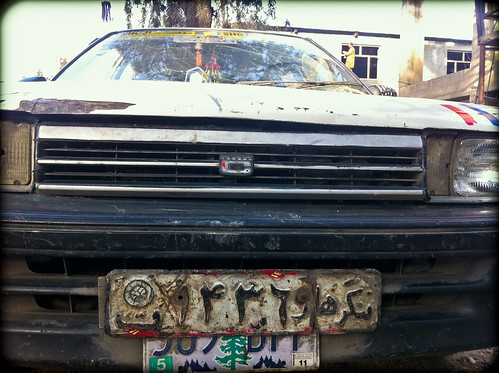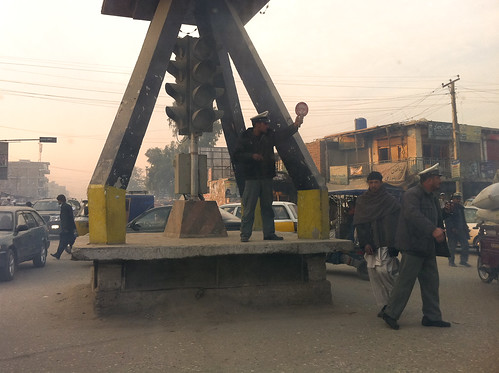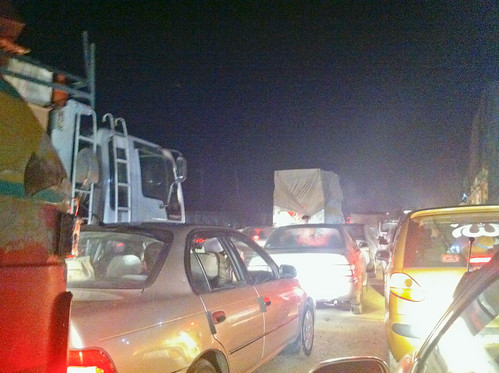Traffic fLaws
Ostensibly, in Afghanistan, traffic drives on the right hand side of the road. However, this rule is leniently applied. In Afghanistan the road is used for driving, and if the left hand side of the road is open, a driver will take it.  Today while cruising down the lane of opposing traffic, we had to edge back into the regular flow to pass a checkpoint. The guard was angry.
“Why were driving on the other side of the street??†He demanded, according to Najib’s translation.
“What did you tell him?†I asked.
“That I had foreign guests in the car! [Referring to us]†Was the answer.
I saw one driver in Kabul even drive up onto the sidewalk. No small commitment because the street is separated from it by a 2 foot deep ditch so he’d have to drive the length of the city block before getting back. Still, the road was full of cars honking but the sidewalk only had pedestrians on it- and they learn quickly to get out of the way.
With all this chaos you’d think that there would be lots of accidents. And you’d be very right. The road from Kabul to Jalalabad winds down gorges for miles before opening up into the plains of Nangarhar. This is where 16,000 British Troops and their families were notoriously slaughtered in their retreat from Kabul in 1842. One lone survivor, Dr. Brydon, made it out of the valley to Jalalabad. As the story goes, the Afghans let him survive so someone could tell the tale. Meanwhile, today the gorge is not dangerous because of IEDs or Afghans shooting from the hills but because of horrible driving. Dr. Baz Mohammad, the director of the Public Hospital told me that in this year already there have been 1400 accidents and 300 deaths on that road. He knows because many of the patients treated at his hospital are victims of those crashes. (The Afghan calendar starts on the Vernal Equinox, and so these figures cover 9 months of accidents, not just 1.)
The main road in the city of Jalalabad has a divider down the middle of it, in a futile attempt to keep traffic on its own side of the road. Often it works, but it’s certainly not uncommon to see a vehicle driving the wrong way on your side of the barrier. They’re committing to driving against traffic, acting on the assumption that traffic flowing against them will all spot them in time to swerve around their oncoming car.
There are no road signs in Jalalabad. Drivers indicate they are passing by honking loudly. No on uses left or right blinkers as turn signals, but it is locally understood that flashing your blinkers means you plan on hurtling straight through an intersection, regardless of oncoming traffic. The only streetlights in the city are found at one particularly busy traffic circle in the middle of town. They aren’t powered. Instead, a cop with a shrill whistle and a stop sign the size of small diner plate stands in front of the lights, waving his sign menacingly while being thoroughly ignored by the cars fighting to get by. Roundabouts are common here, and drivers usually go the same way around them. Not always.
Taking a turn, especially a left-hand one, is not for the overly carious. Cars will not let you turn unless you give them no other option. The only way you’ll be let into the flow of traffic on a busy street is if you get the hood of your corolla nosed in far enough that cars can’t swerve around it. The rule of the road is that you never give up space to anyone if you can’t help it. This includes budging an inch for the army truck with 4 men holding AKs in the back trying to wedge its way into traffic. No exceptions given. When we riding in the Teaching Hospital’s Ambulance (they sent it to the Taj for our ride) its driver turned on the siren in a vain attempt to push faster through traffic. The siren had little effect. It could barely be heard above the honking of horns, not that people would have heeded it if it had been louder.
Parking is also haphazard. There aren’t really parking spots downtown so much as there are gaps between food carts where you can stash your car for a while. The cops, Mehrab told me, don’t give tickets because “no one would pay them.†Instead, they go around with a screwdriver and take the license plate of cars parked “illegally.†(The vast majority of parked cars here would qualify as this in America.) That way, drivers have to go to the police station and pay to get their license plate back. The fee is nominal, but the hassle of having to pick it up is supposed to deter.

Most cars are bought on auction in America (after having been totaled) imported and repaired. You often see plates from CA, MA, TX, and even from Canada.
The oddest accident I’ve almost gotten into involved a van diving in front of us whose wheel popped completely off the vehicle. Maybe the nuts weren’t tightened, otherwise they were rusted completely through because the whole tire with its wheel popped off the axle and flew across the road, into oncoming traffic, smashed into the front of a car going the other way, and ricocheted back into our lane. Najib slammed on the brakes as the tire bounced across the road in front of us. Meanwhile the driver of the van had managed to keep control and pull it over to the side, undamaged if you don’t count the missing tire.  The car that took the brunt of the tire seemed to have a smashed front light, but little other damaged. And we cruised between the two stopped vehicles, heading into town.





